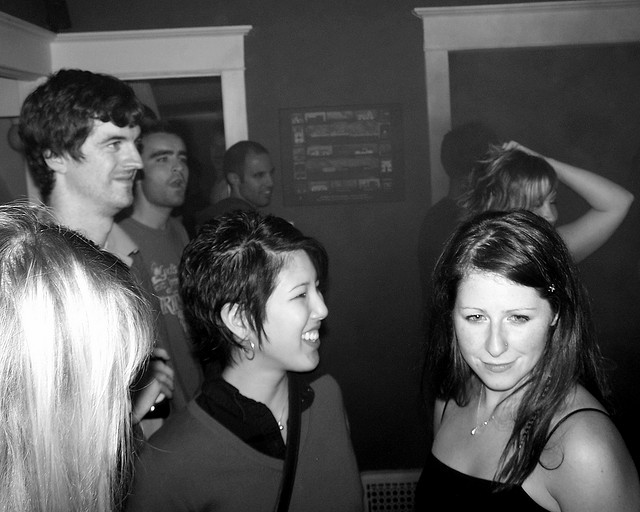Kate Folk
Freshman year I lived in a dorm on Fifth Avenue. It was the same year many students flung themselves to their deaths from upper floors of the NYU library. Plexiglass barriers were installed after the third suicide.
Sophomore year I lived in a dorm on Broome Street, at the border of Little Italy and Chinatown. Our room was on the third floor. The windows faced Kenmare. Evenings, I lay in bed and stared at the building across the street, at two windows whose blinds were always drawn. Sometimes one window’s light would flicker in a way that seemed deliberate. Slowly, at irregular intervals, as if a person were turning off the light, waiting, then turning it back on. Sometimes the pace would quicken to a frenzy. Then it would slow again. I came to believe this was a distress signal from someone trapped in the apartment. I think about it still. It has become one of the great mysteries of my life.
We all have interests. I know a woman named Marie who, in her middle age, became a Civil War history buff. She toured battlefields across the south with her husband, who had made his fortune in multimedia tombstones. The husband soon grew bored with these tours and opted to stay home. On one trip, Marie met a man in a bar in Richmond. She was trying to sign her bill, but the pen didn’t work. The man—handsome, with long, wheaten hair—warmed the pen’s tip with a lighter, which made the ink flow again. His name was Kevin Taylor. He was a dressmaker who specialized in historical reproductions. What a coincidence! Marie had been looking to commission a ball gown. She was hoping to attend a Civil War gala that summer in Raleigh. Kevin Taylor promised Marie an emerald, crushed velvet Scarlett O’Hara dress, historically accurate in every detail. She gave him a down payment of two hundred fifty dollars on the spot.
Over the next two years, Marie returned to Richmond many times. She met Kevin Taylor in motel rooms, oily-walled bars and bright airport lounges. To their meetings he would bring pictures of the dress-in-progress, as if it were his hostage. Sometimes, he brought a sleeve.
Kevin Taylor always needed more money—an extra hundred for corset boning, fifty for additional lace. Marie’s husband wanted to call Kevin Taylor and put the pressure on, but Marie insisted that you couldn’t rush an artist.
At last Kevin Taylor said the dress was ready. They agreed to meet in Richmond again. Marie gave Kevin Taylor the phone number of the bed and breakfast where she’d be staying. When he called, he said there was a problem. He had the dress, but the hoop skirt was locked up in a factory. The man with the key to the factory was out of town until Monday, after Marie would already be gone.
At that point Marie’s husband, the gravestone mogul, said enough was enough. Marie agreed to give up the chase. For the next five years, she continued to receive, in the mail, Polaroids of disembodied portions of the dress. Once, an almond-shaped swatch of green velvet cut with pinking shears. Finally Kevin Taylor sent a letter. He wrote that he was sorry he had, for the past seven years, defrauded Marie with the promise of the dress. He had not actually been making it for most of those years. But now, the dress was truly finished. He included prints from a disposable camera. The dress lay on a motel bedspread. It was exquisite, exactly as Marie had imagined.
Kevin Taylor said he didn’t want any more money. He just wanted Marie to have the dress, his masterpiece. Say the word, he wrote, and I’ll send it.
Marie threw the letter in the trash. Her marriage was falling apart. In any case, her tastes by then had shifted to later wars.
Night after night, the light in the window transmitted its message. It began flickering around six, and had gone dark for the night by seven. I was convinced that someone was being held prisoner in the room. I pictured a man tied to a straight-backed chair. All day he was tortured, except for one twilit hour when his captors went out for a slice. Alone at last, the captive would hop with his chair to the light switch, and try desperately to communicate with someone in my building, using the Morse code he had learned as a Boy Scout.
Bert and Sheila vacationed in Sarasota every spring, out of an old habit, though Florida bored them. One year, they visited a psychic. Sheila’s report was positive. Vague good fortune was promised. The psychic paused when it came to Bert. She said she had some troubling news. Bert, the psychic said, had in a past life been a woman who was violently drowned. This explained Bert’s severe, lifelong asthma; it was the habit of the drowned woman, who still resided in Bert’s soul, to gasp for air.
Bert returned to the Midwest, where he was an ophthalmologist at a large teaching hospital. He stayed in contact with the psychic, who guided him in a procedure to banish the drowned woman from his soul. First, the psychic told him to withdraw ten hundred dollar bills from the bank. New bills, freshly minted. Bert was instructed to pin the bills somewhere against his skin and keep them there for a whole day. Bert pinned them inside his underwear—white briefs—and forgot they were there. That afternoon he had his yearly physical, performed by one of his colleagues, Doug, a generalist. Doug asked Bert to remove his underwear. The briefs were already on the floor when Bert remembered the hundreds pinned inside. Bert watched Doug see the bills. He did not try to explain. He hoped it would add to his mystique.
The psychic was pleased that Bert had followed her instructions. She said the last step was to send her the money, so she could destroy it in a ritual of purification. At this point Bert knew it was a scam. He hung up on the psychic. He was spending his underwear money for months, on bagels and coffees, packs of gum, hot dogs in the hospital cafeteria. He kept the hundreds in the sock drawer and peeled another off when his wallet was empty. It seemed like the underwear money would never run out. Until one day, of course, it did.
On New Year’s Eve, a party was held at a man’s house south of the city in which many of us, at that time, lived. Guests lingered over a glutted snack table. Out of profound discomfort, they gorged themselves on baby carrots and buckets of miniature Trader Joe’s cookies. Smokers went on the front porch and smoked. Non-smokers joined them just to escape the house. The porch soon became intolerable in the same mysterious way, and everyone drifted back into the house, which they found to be just as oppressive as it had been, five or ten minutes before, when they had fled to the porch. Everyone suffered, but no one felt they could leave. The longer they stalled in deciding, the closer the clock crept toward midnight. They were deep in the suburbs, too far to get anywhere else before the new year. Together, they endured.
Long after that night, strangers who had attended the party located each other on the streets, in cafes and near the snack tables of superior parties. They bonded over how awful they had felt that night, though no one could explain exactly why the party had been so torturous. News of this collective trauma traveled back to the fastidious, marginally wealthy bachelor who had hosted the party. He was upset; he had considered his New Year’s party a success. The man closed his door to all visitors. The house fell into disrepair. Years passed.
As for the flickering light in the window of the building on Kenmare—I considered calling the police, but decided it was none of my business. The semester ended and everyone moved to Brooklyn.
Kate Folk’s fiction has appeared in Colorado Review, Word Riot, Puerto del Sol, Gigantic Sequins, and elsewhere. She was a 2014 fellow at the San Francisco Writers’ Grotto. Find her on twitter at @katefolk or at her website, www.katefolk.com.



